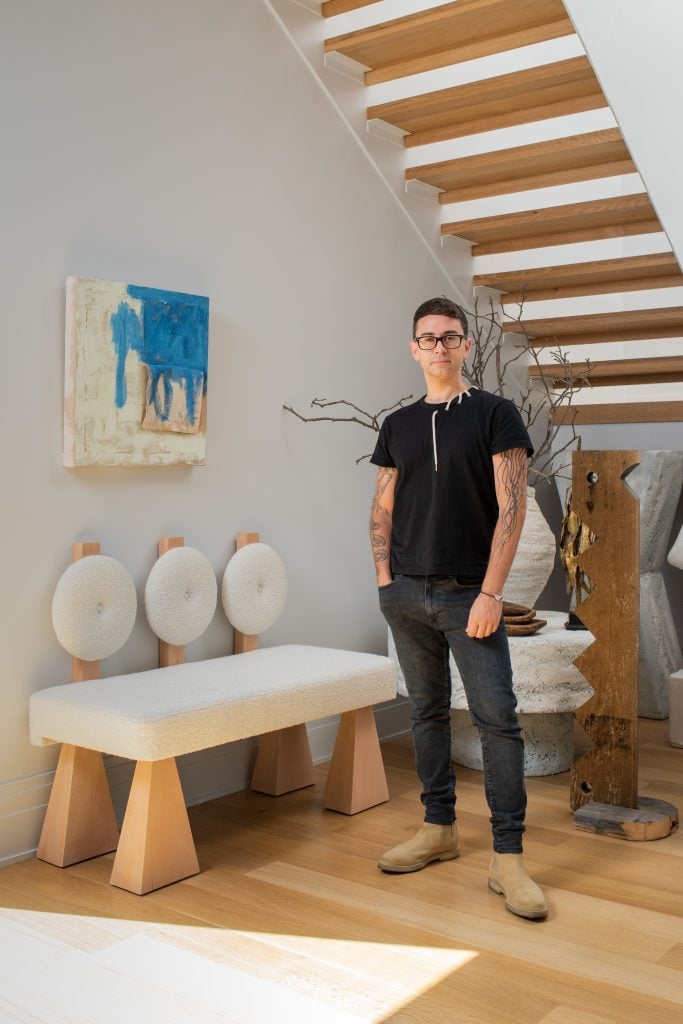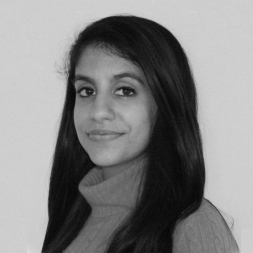The award-winning fashion designer Christian Siriano has made his name creating fantastical, out-of-this-world gowns that sometimes resemble artworks as much as they do dresses.
After winning Project Runway’s fourth season and founding his eponymous label in 2008, the 35-year-old designer has become one of the fashion world’s most tapped young talents. Clients including Lady Gaga, Michelle Obama, Angelina Jolie, Cardi B, and Scarlett Johansson regularly turn up on the red carpet outfitted in sculptural pieces that reflect his love of, and background in, the visual arts.
In 2018, Siriano dressed a record 17 women at the Academy Awards. The following year, the actor Billy Porter debuted one of the designer’s most renowned creations—a tuxedo jacket from which bloomed a strapless, full-skirted velvet black gown—at the Oscars, becoming that year’s most Google-searched red-carpet look and cementing Siriano as a designer who cares deeply about inclusivity in fashion.
This year, Siriano has branched out further, breaking down boundaries among creative disciplines. He launched an interior design studio that seeks to create spaces with the same spirit and verve as his colorful gowns and he has even begun making and exhibiting his own fine art. He also has three dresses on view at the Metropolitan Museum of Art Costume Institute show “In America: A Lexicon” and returned as a judge on Project Runway’s 19th season, which premiered last week.
At home in Westport, Connecticut, Siriano has amassed a sizable art collection that lives alongside bold design objects to create a space that is both rejuvenating and inspiring. The designer sat down with Artnet News for an exclusive conversation about his love affair with art, the differences between art and fashion, and why he hopes to paint in retirement.
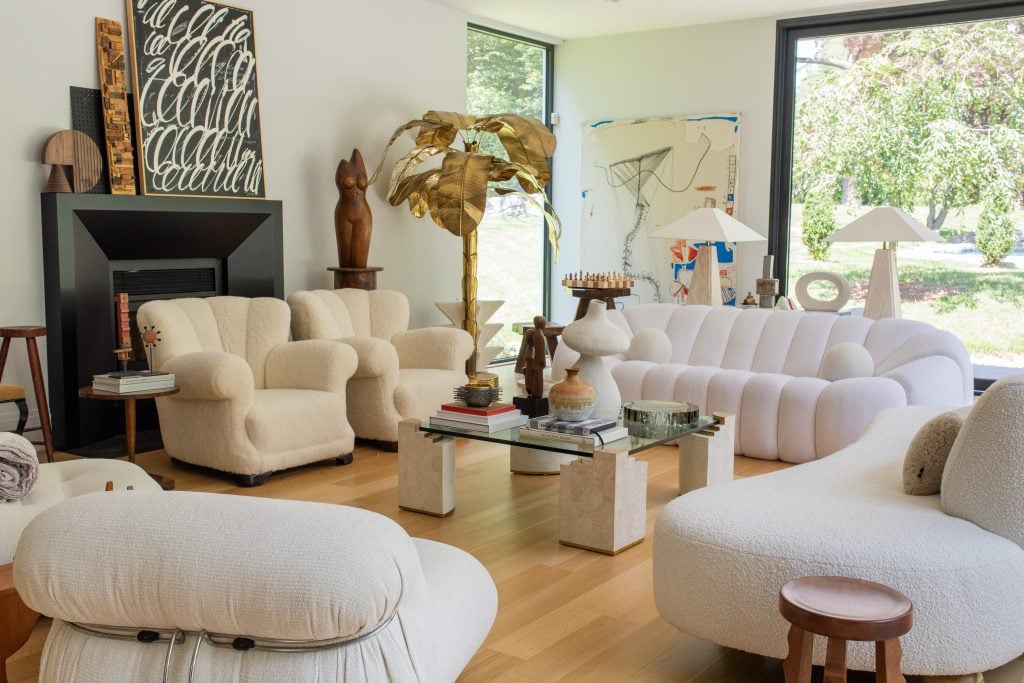
Siriano’s dreamy living room houses works by artists including Josh Young (on the left wall) and Istanbul-based painter Eser Gündüz (back wall). Photo: Taylor Dafoe.
Do you remember the first time you engaged with a work of art?
I don’t know if there was a specific painting or anything, but I went to an art high school, Baltimore School for the Arts. I was really different from a lot of kids I knew in that sense, since I was constantly surrounded by creatives. That was really helpful in my development and impacted how I thought about craft. I learned how to do fine-art painting before I was even in fashion, so that informs my love for art and artists, and more specifically, my desire to support young and underrepresented artists.
Which visual artists influence your eye as a designer?
There are a lot of people—it’s constantly changing. There’s an artist I love named Gee Gee Collins and another who’s based in Connecticut named Meagan Morrison. I’m really into this newer artist named Colt Seager and also Josh Young. I’ve been buying a lot of photographs by Bill Emrich.
What was your first purchase and how much did you pay for it?
Probably a Bruce Weber [photograph]. I can’t remember how much I paid for it.
What was your most recent purchase?
I just bought a funny, cheeky, tiny painting of a white cup by Gordon Winarick. It’s super simple and something about it is very engaging; you could stare at it for a long time and it takes you somewhere. It’s 10 x 8 but it’s very impactful for such a small piece. Another work I just bought is by Ewa Matyja—her stuff is very abstract, black and white and graphic. It reminds me of fabric, which is probably what drew me to it. It looks like textiles that I would make clothes out of.
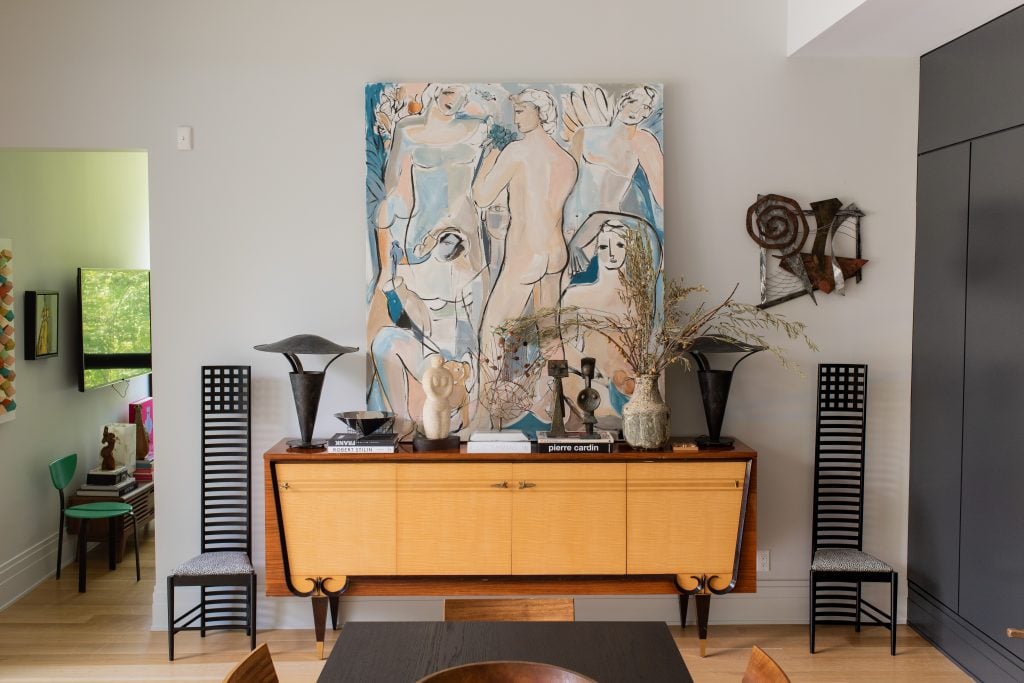
A painting by Gee Gee Collins sits atop a midcentury modern console table in Siriano’s home.
What artists are you hoping to add to your collection in the near future?
I was just saying I want to up my photography game. And there’s this artist, Peggy Kuiper, whose paintings are really strange and kind of dark; I really want one of them.
What is the most valuable artwork that you own?
I have a couple big paintings by the artist Ashley Longshore. Ashley’s having a pretty big moment in pop culture, and her pieces are going for quite a lot now.
Where do you buy art most frequently? How do you go about acquiring artwork?
A lot of it is through social. I follow a lot of interior designers and art sites, and then sometimes just through friends of friends, I’ll find out about someone. I’m really direct, so I like to just reach out to the artist and say, “I love your work,” and usually that’s how I buy things. I think it’s the best way.
Is there any artwork that you regret purchasing?
Oh, never. Oh my god. Sometimes I’ll buy something silly that was maybe expensive in the moment and then later on, after it’s traveled to different houses or apartments, it has a better story. I acquired a few outdoor sculptures lately which are maybe frivolous, but I love them. The artist Domenico Belli came to my house and placed them in the yard and it was a blast. I was only going to buy one and I ended up buying three. Now, I want to turn that space into an outdoor gallery. That’s what happens when people collect art: once you start, it’s hard to stop. Maybe it’s different for me and for creators who collect, because I look at the work and think, “Oh, maybe this will inspire a collection or a gown.”
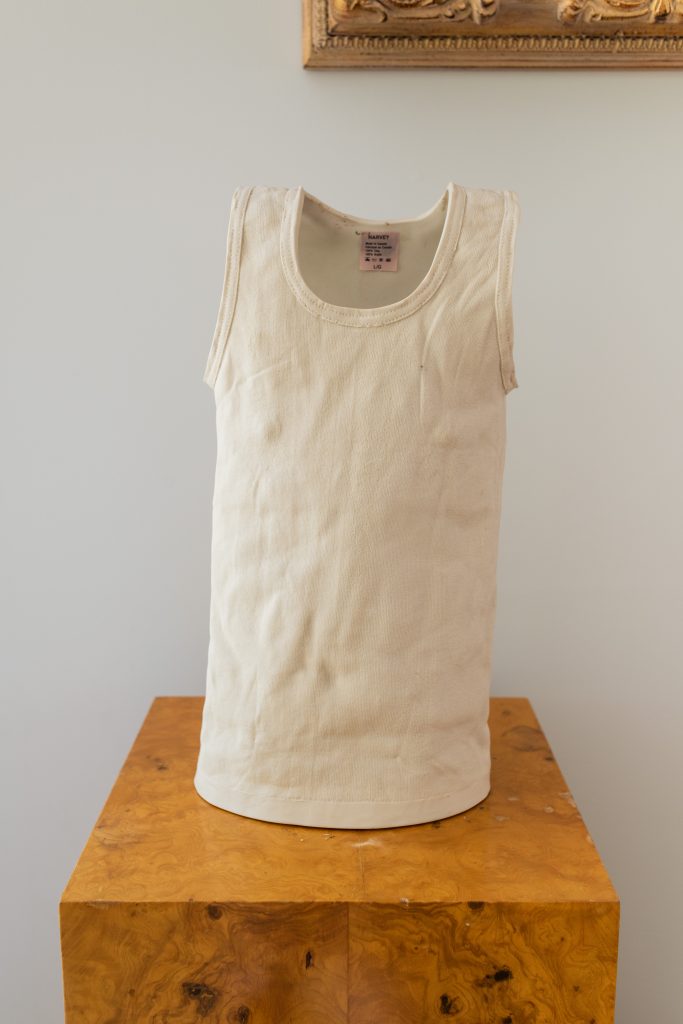
A ceramic tank top sculpture by Michael Harvey. Photo: Taylor Dafoe.
What do you have hanging above your sofa?
My giant Ashley Longshore painting is in the T.V. room where we hang out and lounge.
Do you have anything in or around your closet?
I have a really cool sculpture—I actually bought it at an antique store, so I don’t know who the artist is, but it’s a ceramic button-down shirt that’s halved. I thought that was sort of funny.
What do you feel is the most impactful work that you own?
Probably my four paintings by Gee Gee Collins. She’s a young artist and I’m not sure how many people know who she is, but when people come to stay, they ask me most about her work. Her use of color is compelling and a lot of her works depict, thematically, the Madonna and Child. They kind of have—I don’t want to say religious undertones, but they remind me of familiar historical works in a sense. They’re not for everybody, but in a big white space, they’re very impactful.
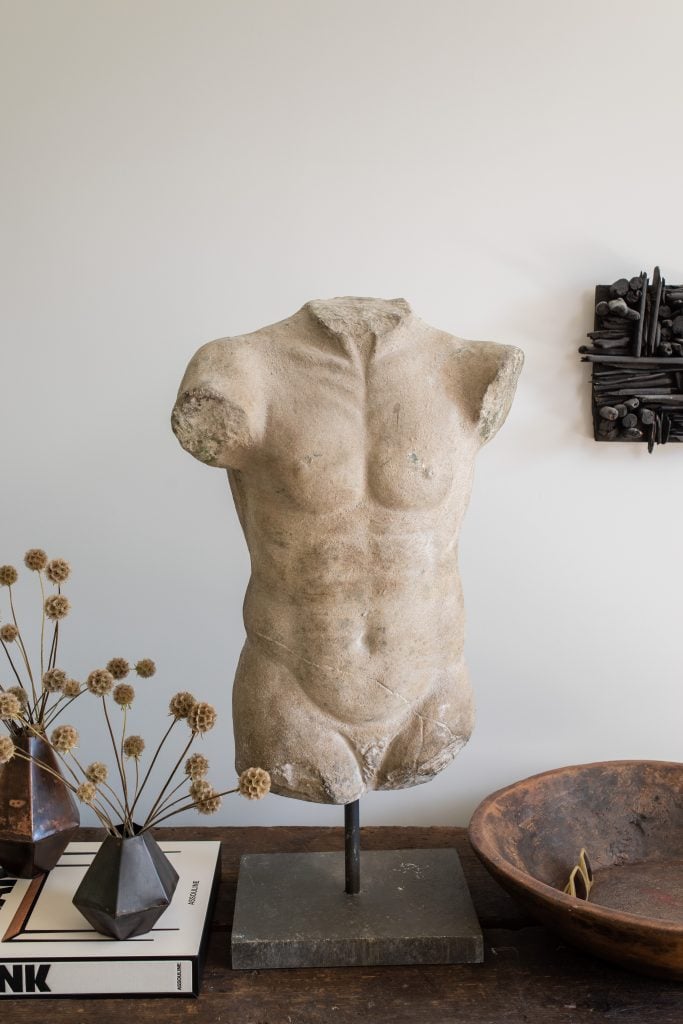
A plaster antique, part of Siriano’s collection. Photo: Taylor Dafoe.
What work do you wish you had bought when you had the chance?
I’m a pretty instinctual buyer—if I want something, I usually get it. But I’m also not a massive, crazy collector. There was a cool Keith Haring print I wanted recently, but I didn’t get it because I was like, “Maybe, I’m being crazy.”
If you could steal a work of art without getting caught, what would you steal?
It would have to be a Basquiat. Any old Basquiat piece would be something to have.
“Something to have”—I like that. In addition to your design work, you’ve been doing some painting of your own lately. Can you tell me a little about that?
It’s kind of a mix… I definitely like doing abstract, experimental things. I think about manipulated fabric and how I might depict it. Painting has been just a fun way to relax… the works are like abstract versions of pieces that I’ve made that I’ve put into canvases. That’s primarily what it is.
What do you feel painting offers you that fashion design does not?
It’s a different outlet. I can’t always buy a fabric color that’s exactly what’s in my head and I can’t quickly realize an idea because it takes a long time to make clothes. To make a big tulle gown can take up to three weeks. So painting and sketching is this very visceral reaction to the moment I have an idea. I get it on a piece of paper as soon as I think of it. That’s the best way to explain it. It becomes something right away.
The immediacy is probably really gratifying.
Exactly.
Do you enjoy creating something entirely on your own, as opposed to working with a team as you do with your fashion or interior design work?
It’s really nice to have something that literally no one else is involved with in any way. I think that’s also probably why artists become these solitary creatures, because there’s nobody else that’s necessarily part of their process. And you’re going through a lot of emotions because it’s very personal.
Over the summer, you had a show at Swoon, a gallery near your home in Westport. What was that like?
During the pandemic, I started painting a lot more because I had time. The show is just an experiment to see if people are interested, but in no way would I ever want to take away from other artists who spend their whole lives working hard. So that’s not really what it is—it’s more like just expressing myself through a different creative outlet. The woman who curates Swoon has a lot of different types of art, but my fashion illustrations and paintings were doing quite well with her… we sold over 100 pieces. And I was like, “Oh, maybe let’s do a show.” I’ll do sketches for $100 and big paintings that are $10,000, so the range is really interesting too. The difference is when I do a drawing of a painting or a dress, I make versions of those dresses… it’s not a sketch of nothing. But there is a comfort in knowing that [these images] sort of just live in the paintings.

Siriano finds inspiration in Annie Leibovitz’s SUMO photography book. Photo: Taylor Dafoe.
What does your studio practice look like?
It’s a relaxing process and sort of an in-the-moment thing. I can do 30 pieces in a day because it’s so reactionary. It’s kind of like when I make a collection, one dress inspires the next and then that inspires a skirt and then that inspires a top. That’s how it all happens.
What in your mind do you feel is the biggest difference between art and design?
There are a lot of similarities because you’re color processing and you’re trying to give people emotion through something physical. Obviously artwork is hung on a wall and designers are putting our art on someone’s body to live their life in. With clothing, there are so many things to think about—the fit, the person; it can get annoying. With painting or sketching, there are fewer rules. But I’d say they come from similar parts of the brain.
Could you ever see yourself switching to art full time?
Totally. I would love to just sit and paint and sketch all day. I think when I’m old and can’t make anything fashion-wise anymore, that’s what I would do.
What is one thing that you feel like the fashion world could learn or take from the art world?
Fashion is ultimately for a customer, whereas with experimental art, it’s so much more open to interpretation. That’s what I wish we had more of. We as fashion designers are judged in such a different way, even though it is a similar process and we are creating what we want to create. Turning a flat piece of fabric into a three-dimensional form is a very powerful form of sculpting. I think people forget that, because they’re so used to shopping at the mall or whatever. A lot of work goes into making clothes—it’s so mathematical and technical.
What advice would you give to a young artist, fashion designer, or creative?
They should create anything and everything they love. Never think that something doesn’t go with something else. Art and fashion and design is about falling in love with shapes, textures, and colors you are inspired by. Inspiration has no rules.
A version of this article appears in the fall 2021 Artnet Intelligence Report, available exclusively to Artnet News Pro members. To read more about the tech tools poised to revolutionize the art world, which galleries throw the best parties, and how much money NFTs are making for auction houses, download the full report here.
To become an Artnet News Pro member, subscribe here.
